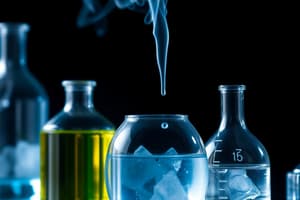Podcast
Questions and Answers
Which of the following is NOT a typical characteristic of a compound formed through ionic bonding?
Which of the following is NOT a typical characteristic of a compound formed through ionic bonding?
- Formation of discrete, individual molecules (correct)
- Good electrical conductivity when dissolved in water
- Crystalline structure in the solid state
- High melting and boiling points
In comparing the rates of reactions, how does the presence of a catalyst affect the activation energy ((E_a)) and the rate constant (k) of a reaction?
In comparing the rates of reactions, how does the presence of a catalyst affect the activation energy ((E_a)) and the rate constant (k) of a reaction?
- Increases \(E_a\), decreases k
- Decreases \(E_a\), increases k (correct)
- Decreases both \(E_a\) and k
- Increases both \(E_a\) and k
Consider a buffer solution prepared from a weak acid HA and its conjugate base A. Under what condition will the buffer be most effective at resisting changes in pH upon addition of strong acid or base?
Consider a buffer solution prepared from a weak acid HA and its conjugate base A. Under what condition will the buffer be most effective at resisting changes in pH upon addition of strong acid or base?
- When the concentration of HA is much greater than the concentration of A
- When the pH of the solution is far from the pKa of HA
- When the concentrations of HA and A are equal (correct)
- When the concentration of A is much greater than the concentration of HA
For a voltaic cell based on the reaction: $$2Ag^+(aq) + Cu(s) \rightarrow 2Ag(s) + Cu^{2+}(aq)$$, which change will increase the cell potential?
For a voltaic cell based on the reaction: $$2Ag^+(aq) + Cu(s) \rightarrow 2Ag(s) + Cu^{2+}(aq)$$, which change will increase the cell potential?
Which statement accurately describes the relationship between enthalpy ($\Delta H$), entropy ($\Delta S$) and Gibbs free energy ($\Delta G$) and spontaneity of a reaction at constant temperature and pressure?
Which statement accurately describes the relationship between enthalpy ($\Delta H$), entropy ($\Delta S$) and Gibbs free energy ($\Delta G$) and spontaneity of a reaction at constant temperature and pressure?
Flashcards
Ionic Bond
Ionic Bond
A chemical bond formed through the electrostatic attraction between oppositely charged ions.
Covalent Bond
Covalent Bond
A chemical bond that involves the sharing of electron pairs between atoms.
Organic Compounds
Organic Compounds
Compounds containing carbon atoms (but not all, e.g., carbonates and oxides are not). Key element: Carbon.
Intramolecular Forces
Intramolecular Forces
Signup and view all the flashcards
Thermochemistry
Thermochemistry
Signup and view all the flashcards
Study Notes
- Chemical bonds include ionic and covalent bonds.
- Organic compounds are a major class of chemical compounds.
- Intramolecular forces affects liquids and solids.
- Solutions have physical properties.
- Thermochemistry involves the study of heat and chemical reactions.
- Chemical kinetics studies reaction rates.
- Chemical thermodynamics studies the relationship between heat, work, and energy.
- Chemical equilibrium represents the state where the rates of forward and reverse reactions are equal.
- Acid-base equilibria involves acid-base reactions in solutions, including salt equilibria.
- Electrochemistry studies the relationship between electricity and chemical reactions.
Studying That Suits You
Use AI to generate personalized quizzes and flashcards to suit your learning preferences.



